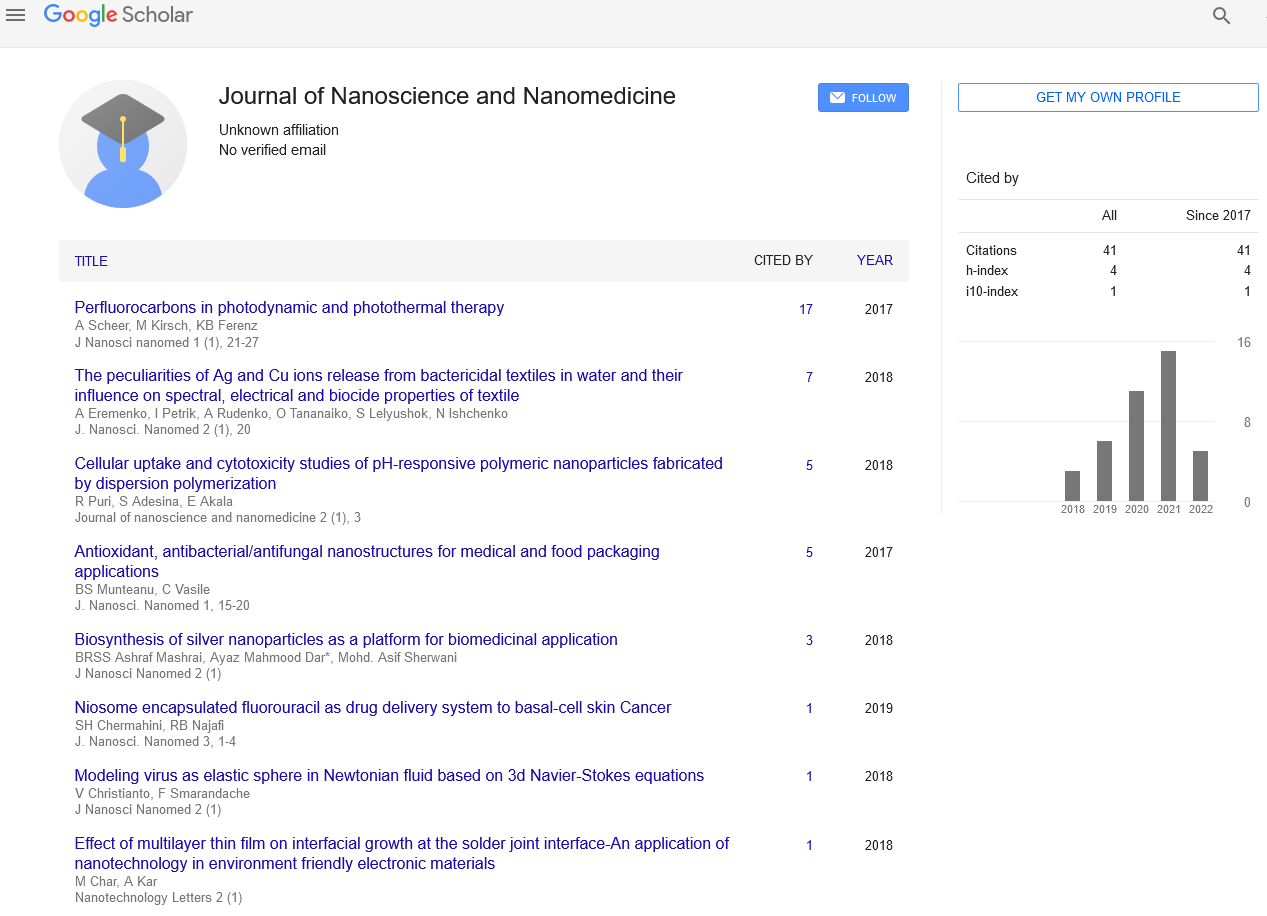Impact of nanostructured surfaces on electronic, optical, sensors nanocomponents
Received: 09-Sep-2021 Accepted Date: Sep 23, 2021; Published: 30-Sep-2021
Citation: Tong B. Impact of nanostructured surfaces on electronic, optical, sensors nanocomponents. J Nanosci Nanomed 2021;5(5):4.
This open-access article is distributed under the terms of the Creative Commons Attribution Non-Commercial License (CC BY-NC) (http://creativecommons.org/licenses/by-nc/4.0/), which permits reuse, distribution and reproduction of the article, provided that the original work is properly cited and the reuse is restricted to noncommercial purposes. For commercial reuse, contact reprints@pulsus.com
Abstract
A sensor could be a gadget which identifies a variable amount, as a rule electronically, and converts the estimation into particular signals. The foremost vital prerequisites of sensors are differing qualities, affectability, and exactness of data extricated, selectivity, and stability. Nanosensors are connected for observing physical and chemical marvels in districts difficult to reach, identifying biochemicals in cellular organelles, measuring nanoscopic particles within the industry and environment.
Keywords
Nanostructured surfaces on electronic; Optical; Sensors nanocomponents
Introduction
Nanosensors are detecting gadgets with at slightest one of their detecting measurements being up to100 nm. Within the field of nanotechnology, nanosensors are instrumental for (a) recognizing physical and chemical changes, (b) checking biomolecules and biochemical changes in cells, and (c) measuring poisonous and polluting materials displayed within the industry and environment. Nanosensors can be classified agreeing to their vitality source, structure and applications. The nanostructured materials utilized in fabricating of nanosensors are such as: nanoscale wires (capability of tall location affectability), carbon nanotubes (exceptionally tall surface region and tall electron conductivity), lean movies, metal and metal oxides nanoparticles, polymer and biomaterials. The point of this survey is to supply a diagram of all classifications of nanosensors, appearing the characteristcs and working components among the different categories.
Microfluidic biosensors (biosensors-on-chip) or (lap-on-chip) are fundamental for creating vigorous and taken a toll compelling point-of-care diagnostics. The integration of microfluidic and biosensor advances gives the capacity to consolidate chemical and organic components into a single stage and offers modern approach for biosensing applications such as compactness, disposability, real-time location, uncommon exactnesses, and concurrent examination of distinctive analytes in a single device. Utilized this strategy for discovery of nucleic acids, which are show at noteworthy levels within the blood of cancer patients.
Nanomaterials Connected for Nanosensors Recently, nanostructures from metal, metal oxide, carbon nanotubes, graphene, have been broadly investigated for chemiresistive detecting applications. The little estimate and tall surface to volume proportion of nanomaterials gives a few benefits for detecting over more than the conventional bulk movies [1,2].
Carbon based nano materials have amazing properties such as great conductivity, tall steadiness, moo fetched, wide potential windows and simple surface functionalization. Permeable carbon is characterized by a tall surface range, available surface chemistry, and brief pathway for mass and electron exchange. It has pulled in impressive consideration within the field of electrochemical sensors. [3].
Polymer and bio-nanomaterials. The nanostructures electrochemical sensors and biosensors based on polymeric and biomaterials appeared tall execution with fast reaction and selectivity. Usually credited to their brilliant, electrical, catalytic, mechanical, warm and physical properties [4].
Polymer nanomaterials many exertions on the innovation of polymeric nanomaterials have been set up for the location of nourishment and natural toxins. Polymeric nanomaterials give numerous expository methodologies for the location and assurance of the chemically and organic harmful contaminations in gasses and fluids for various wellbeing and natural applications. The creation of the nano-composites with numerous combinations such as; metal nanoparticles, metal oxide nanoparticles, (carbon nanotube) CNT and graphene advance make strides the electrochemical detecting properties of polymeric nanomaterials.
Bio-nanomaterials the combination of the catalytic work of biomolecules with extraordinary characteristics nanoscale materials gives various for nanosensors. A well-defined nanostructure with biomaterials can be gotten by the self-organization of natural particles. Sabela and co-workers have created MWNTs nanobiocomposite of L-phenylalanine ammonia-lyase chemical for electrochemical biosensing of capsaicin [5].
Conclusion
Numerous sorts of nanosensors have been surveyed, categorized and talked about agreeing to vitality source, structure, and materials. In common, optical nanosensors are exceptionally valuable for chemicals checking interior a single cell. Electromagnetic nanosensors are connected for both chemical detecting as well as electromagnetic-mechatronic estimations. In the interim, mechanical nanosensors are utilized for deciding the physico-mechanical properties and movement estimations. Numerous nanostructured materials connected for nanosensors were displayed such as: metal, metal oxide, carbon nanotubes, graphene, polymers and biomaterials. In spite of the moderately brief history of nanosensors, the advance set up in this region has been momentous. With the proceeding advance in nanotechnology apparatuses and expanding investigate on the nano-scale marvels, one may anticipate encourage accomplishments within the field of nanosensors.
REFERENCES
- Ahmad MZ, Sadek AZ, Ou JZ, et al. Facile synthesis of nanostructured WO3 thin films and their characterization for ethanol sensing. Materials Chemistry and Physics. 2013;141(2-3): 912–919.
- Xiong Y, Zhu Z, Guo T, et al. Synthesis of nanowire bundle-like WO3-W18O49 heterostructures for highly sensitive NH3 sensor application. J Haz Mat. 2018;353:290–299.
- Adhikari S, Swain R, Sarkar D, et al. Wedge-like WO3 architectures for efficient electrochromism and photoelectrocatalytic activity towards water pollutants. Molecular Catalysis. 2017;432(9):76–87.
- Yuan G, Hua C, Khan S, et al. Improved electrochromic performance of WO3 films with size controlled nanorods. Electrochimica Acta. 2018;260:274–280.
- Wang WQ, Wang X, Xia XH, et al. Enhanced electrochromic and energy storage performance in mesoporous WO3 film and its application in a bi-functional smart window. Nanoscale. 2018;10(17):8162–8169.





